Structural Analysis of an In-Wheel Motor with Integrated Magnetic Gear Designed for Automotive Applications
Abstract
1. Introduction
2. The Topology under Study and the Main Steps in the Analytical Design
- A.
- Structure Under Study, the IWM-IMG
- B. Characteristics of the Used Materials
- C. Main Designing Steps
- D.
- Electromechanical Characteristics
3. Structural Analysis of the Proposed IWM-IMG
- A.
- Analytical Structural Model of the IWM-IMG
- B.
- Numerical Structural Analysis of the Studied IWM-IMG
- C.
- Experimental Structural Analysis of the Studied IWM-IMG
- C.1.
- Impact test of the IWM-IMG
- C.2.
- Acoustic tests
4. Discussions
Author Contributions
Funding
Institutional Review Board Statement
Informed Consent Statement
Data Availability Statement
Conflicts of Interest
References
- Huang, B.; Hu, M.; Zeng, L.; Fu, G.; Jia, Q. Design Method for Hybrid Electric Vehicle Powertrain Configuration with a Single Motor. Sustainability 2022, 14, 8225. [Google Scholar] [CrossRef]
- Xu, S.; Wei, L.; Zhang, X.; Bai, Z.; Jiao, Y. Research on Multi-Mode Drive Optimization Control Strategy of Four-Wheel-Drive Electric Vehicles with Multiple Motors. Sustainability 2022, 14, 7378. [Google Scholar] [CrossRef]
- Wang, R.; Xing, Q.; Chen, Z.; Zhang, Z.; Liu, B. Modeling and Analysis of Electric Vehicle User Behavior Based on Full Data Chain Driven. Sustainability 2022, 14, 8600. [Google Scholar] [CrossRef]
- Manutworakit, P.; Choocharukul, K. Factors Influencing Battery Electric Vehicle Adoption in Thailand—Expanding the Unified Theory of Acceptance and Use of Technology’s Variables. Sustainability 2022, 14, 8482. [Google Scholar] [CrossRef]
- Muzir, N.A.Q.; Mojumder, M.R.H.; Hasanuzzaman, M.; Selvaraj, J. Challenges of Electric Vehicles and Their Prospects in Malaysia: A Comprehensive Review. Sustainability 2022, 14, 8320. [Google Scholar] [CrossRef]
- Popa, D.C.; Fodorean, D. Design and performances evaluation of a high speed induction motor used for the propulsion of an electric vehicle. In Proceedings of the SPEEDAM 2014—Symposium on Power Electronics, Electrical Drives, Automation and Motion, Ischia, Italy, 18–20 June 2014; pp. 88–93. [Google Scholar]
- Fodorean, D. State of the art of magnetic gears, their design, and characteristics with respect to EV application. In Modeling and Simulation for Electric Vehicle Applications; IntechOpen: Rijeka, Croatia, 2016. [Google Scholar]
- Jørgensen, F.T.; Andersen, T.O.; Rasmussen, P.O. The cycloid permanent magnetic gear. In Proceedings of the Conference Record of the 2006 IEEE Industry Applications Conference Forty-First IAS Annual Meeting, Tampa, FL, USA, 8–12 October 2006; IEEE: Piscataway, NJ, USA, 2006; pp. 373–378. [Google Scholar]
- Armstrong, C.G. Power Transmitting Device. U.S. Patent 687292, 26 November 1901. [Google Scholar]
- Faus, H.T. Magnet Gearing. U.S. Patent 2243555, 27 May 1941. [Google Scholar]
- Rand, S. Magnetic Transmission System. U.S. Patent 3523204, 4 August 1970. [Google Scholar]
- Hetzel, M. Low Friction Miniature Gear Drive for Transmitting Small Forces, and Method of Making Same. U.S. Patent 3792578, 19 February 1974. [Google Scholar]
- Ikuta, K.; Makita, S.; Arimoto, S. Non-contact magnetic gear for micro transmission mechanism. In Proceedings of the [1991] Proceedings, IEEE Micro Electro Mechanical Systems, Nara, Japan, 30 December 1990–2 January 1991; IEEE: Piscataway, NJ, USA, 1991; pp. 125–130. [Google Scholar]
- Furlani, E.P. A two-dimensional analysis for the coupling of magnetic gears. IEEE Trans. Magn. 1997, 33, 2317–2321. [Google Scholar] [CrossRef]
- Kikuchi, S.; Tsurumoto, K. Design and characteristics of a new magnetic worm gear using permanent magnet. IEEE Trans. Magn. 1993, 29, 2923–2925. [Google Scholar] [CrossRef]
- Kikuchi, S.; Tsurumoto, K. Trial construction of a new magnetic skew gear using permanent magnet. IEEE Trans. Magn. 1994, 30, 4767–4769. [Google Scholar] [CrossRef]
- Atallah, K.; Howe, D. A novel high-performance magnetic gear. IEEE Trans. Magn. 2001, 37, 2844–2846. [Google Scholar] [CrossRef]
- Huang, C.; Tsai, M.; Lin, B. Development of new magnetic planetary gears for transmission systems. In Proceedings of the 2006 IEEE International Magnetics Conference (INTERMAG), San Diego, CA, USA, 8–12 May 2006; IEEE: Piscataway, NJ, USA, 2006; p. 225. [Google Scholar]
- Tsai, M.C.; Huang, C.C. Development of a variable-inertia device with a magnetic planetary gearbox. IEEE/ASME Trans. Mechatron. 2010, 16, 1120–1128. [Google Scholar] [CrossRef]
- Kong, F.; Ge, Y.; Zhu, X.; Qiao, L.; Quan, L. Optimizing design of magnetic planetary gearbox for reduction of cogging torque. In Proceedings of the 2013 IEEE Vehicle Power and Propulsion Conference (VPPC), Beijing, China, 15–18 October 2013; IEEE: Piscataway, NJ, USA, 2013; pp. 1–5. [Google Scholar]
- Rasmussen, P.O.; Andersen, T.O.; Jorgensen, F.T.; Nielsen, O. Development of a high-performance magnetic gear. IEEE Trans. Ind. Appl. 2005, 41, 764–770. [Google Scholar] [CrossRef]
- Li, X.; Chau, K.T.; Cheng, M.; Hua, W. Comparison of magnetic-geared permanent-magnet machines. Prog. Electromagn. Res. 2013, 133, 177–198. [Google Scholar] [CrossRef]
- Huang, C.C.; Tsai, M.C.; Dorrell, D.G.; Lin, B.J. Development of a magnetic planetary gearbox. IEEE Trans. Magn. 2008, 44, 403–412. [Google Scholar] [CrossRef]
- Wang, R.J.; Matthee, A.; Gerber, S.; Tlali, P. Calculation of torque performance of a novel magnetic planetary gear. IEEE Magn. Lett. 2016, 7, 1–5. [Google Scholar] [CrossRef]
- Rens, J.; Atallah, K.; Calverley, S.D.; Howe, D. A novel magnetic harmonic gear. IEEE Trans. Ind. Appl. 2009, 46, 206–212. [Google Scholar] [CrossRef]
- Takahara, K.; Hirata, K.; Niguchi, N.; Suzuki, H.; Kamigakiki, T.; Ukaji, H. Design of Radially-Differential Type Magnetic Harmonic Geared Motor. In Proceedings of the 19th International Symposium on Electromagnetic Fields in Mechatronics, Electrical and Electronic Engineering (ISEF), Nancy, France, 29–31 August 2019; pp. 1–2. [Google Scholar] [CrossRef]
- Mezani, S.; Atallah, K.; Howe, D. A high-performance axial-field magnetic gear. J. Appl. Phys. 2006, 99, 08R303. [Google Scholar] [CrossRef]
- Zhu, Z.Q.; Khatab, M.F.; Li, H.; Liu, Y. A novel axial flux magnetically geared machine for power split application. IEEE Trans. Ind. Appl. 2018, 54, 5954–5966. [Google Scholar] [CrossRef]
- Acharya, V.M.; Calvin, M.; Bird, J.Z. A low torque ripple flux focusing axial magnetic gear. In Proceedings of the 7th IET International Conference on Power Electronics, Machines and Drives (PEMD 2014), Manchester, UK, 8–10 April 2014; IET: London, UK, 2014; pp. 1–6. [Google Scholar]
- Acharya, V.M. Design of a Flux Focusing Axial Magnetic Gear. Master’s Thesis, Electrical and Computer Engineering, University North Carolina at Charlotte, Charlotte, NC, USA, December 2013. [Google Scholar]
- Venturini, M.; Leonardi, F. High torque, low speed joint actuator based on PM brushless motor and magnetic gearing. In Proceedings of the Conference Record of the 1993 IEEE Industry Applications Conference Twenty-Eighth IAS Annual Meeting, Toronto, ON, Canada, 2–8 October 1993; IEEE: Piscataway, NJ, USA, 1993; pp. 37–42. [Google Scholar]
- Hirata, K.; Yamamoto, M.; Muramatsu, M. Proposal of an axial gap magnetic gear. IEEJ Trans. Ind. Appl. 2010, 130, 802–807. [Google Scholar] [CrossRef]
- Li, W.; Chau, K.T. Analytical field calculation for linear tubular magnetic gears using equivalent anisotropic magnetic permeability. Prog. Electromagn. Res. 2012, 127, 155–171. [Google Scholar] [CrossRef]
- Ho, S.L.; Wang, Q.; Niu, S.; Fu, W. A novel magnetic-geared tubular linear machine with Halbach permanent-magnet arrays for tidal energy conversion. IEEE Trans. Magn. 2015, 51, 1–4. [Google Scholar]
- Niu, S.; Ho, S.L.; Fu, W.N. Performance analysis of a novel magnetic-geared tubular linear permanent magnet machine. IEEE Trans. Magn. 2011, 47, 3598–3601. [Google Scholar] [CrossRef]
- Holehouse, R.C.; Atallah, K.; Wang, J. A linear magnetic gear. In Proceedings of the 2012 XXth International Conference on Electrical Machines, Marseille, France, 2–5 September 2012; IEEE: Piscataway, NJ, USA, 2012; pp. 563–569. [Google Scholar]
- Chau, K.T.; Li, W.; Lee, C.H.T. Challenges and opportunities of electric machines for renewable energy. Prog. Electromagn. Res. B 2012, 42, 45–74. [Google Scholar] [CrossRef]
- Li, W.; Chau, K.T.; Jiang, J.Z. Application of linear magnetic gears for pseudo-direct-drive oceanic wave energy harvesting. IEEE Trans. Magn. 2011, 47, 2624–2627. [Google Scholar] [CrossRef]
- Mcgilton, B.; Crozier, R.; McDonald, A.; Mueller, M. Review of magnetic gear technologies and their applications in marine energy. IET Renew. Power Gener. 2018, 12, 174–181. [Google Scholar] [CrossRef]
- Feng, G.N.; Yu, H.; Huang, L.; Zhong, W.; Shi, Z. Performance analysis of a magnetic-geared linear permanent magnet generator for wave energy conversion. In Proceedings of the 2015 IEEE International Magnetics Conference (INTERMAG), Beijing, China, 11–15 May 2015; IEEE: Piscataway, NJ, USA, 2015; p. 1. [Google Scholar]
- Wang, Y.; Filippini, M.; Bianchi, N.; Alotto, P. A review on magnetic gears: Topologies, computational models, and design aspects. IEEE Trans. Ind. Appl. 2019, 55, 4557–4566. [Google Scholar] [CrossRef]
- Fodorean, D. Global design and optimization of a permanent magnet synchronous machine used for light electric vehicle. In Electric Vehicles—Modelling and Simulations; IntechOpen: Rijeka, Croatia, 2011. [Google Scholar]
- Pop, C.V.; Fodorean, D. In-wheel motor with integrated magnetic gear for extended speed applications. In Proceedings of the 2016 International Symposium on Power Electronics, Electrical Drives, Automation and Motion (SPEEDAM), Capri, Italy, 22–24 June 2016; IEEE: Piscataway, NJ, USA, 2016; pp. 413–418. [Google Scholar]
- Pop, C.V.; Fodorean, D. Purely Electromagnetic Propulsion System with Two Transmission Levels–Design, Numerical and Experimental Results. IEEE Trans. Ind. Electron. 2022, in press. [CrossRef]
- Pop, C.V.; Essaid, M.; Idoumghar, L.; Fodorean, D. Novel Differential Evolutionary Optimization Approach for an Integrated Motor-Magnetic Gear Used for Propulsion Systems. IEEE Access 2021, 9, 142114–142128. [Google Scholar] [CrossRef]
- Matyas, A.R.; Biro, K.A.; Fodorean, D. Multi-phase synchronous motor solution for steering applications. Prog. Electromagn. Res. 2012, 131, 63–80. [Google Scholar] [CrossRef]
- Chen, Y.; Zhu, Z.; Ying, S. Analysis and Control of Motor Noise; Zhejiang University Press: Hangzhou, China, 1987. [Google Scholar]
- Oravec, M.; Lipovský, P.; Šmelko, M.; Adamčík, P.; Witoś, M.; Kwaśniewski, J. Low-Frequency Magnetic Fields in Diagnostics of Low-Speed Electrical and Mechanical Systems. Sustainability 2021, 13, 9197. [Google Scholar] [CrossRef]
- Mori, D.; Ishikawa, T. Force and vibration analysis of induction motors. IEEE Trans. Magn. 2005, 41, 1948–1951. [Google Scholar] [CrossRef]
- Wang, T.Y.; Wang, F.X. Vibration and modal analysis of stator of large induction motors. Zhongguo Dianji Gongcheng Xuebao (Proc. Chin. Soc. Electr. Eng.) 2007, 27, 41–45. [Google Scholar]
- Gieras, J.F.; Wang, C.; Lai, J.C. Noise of Polyphase Electric Motors; CRC Press: Boca Raton, FL, USA, 2006. [Google Scholar]
- Wu, J.H. Study on the Stator Mode Shapes and Natural Frequencies of Switched Reluctance Motor Based on Real Structual Model. Proc. Chin. Soc. Electr. Eng. 2004, 24, 109–114. [Google Scholar]
- Yu, S.; Tang, R. Electromagnetic and mechanical characterizations of noise and vibration in permanent magnet synchronous machines. IEEE Trans. Magn. 2006, 42, 1335–1338. [Google Scholar]
- Wang, C.; Lai, J.C.S. Prediction of natural frequencies of finite length circular cylindrical shells. Appl. Acoust. 2000, 59, 385–400. [Google Scholar] [CrossRef]
- Hameyer, K.; Belmans, R. Numerical Modelling and Design of Electrical Machines and Devices; WIT Press: Southampton, UK, 1999. [Google Scholar]
- Kuczmann, M. Potential Formulations in Magnetics Applying the Finite Element Method; Lecture Notes; Laboratory of Electromagnetic Fields, “Széchenyi István” University: Gyor, Hungary, 2009. [Google Scholar]
- Strouboulis, T.; Babuška, I.; Copps, K. The design and analysis of the generalized finite element method. Comput. Methods Appl. Mech. Eng. 2000, 181, 43–69. [Google Scholar] [CrossRef]
- Pop, C.V.; Birte, O.; Fodorean, D. Noise and vibrations analysis of a permanent magnet synchronous machine for light electric vehicle. In Proceedings of the 2017 52nd International Universities Power Engineering Conference (UPEC), Heraklion, Greece, 28–31 August 2017; IEEE: Piscataway, NJ, USA, 2017; pp. 1–5. [Google Scholar]
- Fodorean, D.; Sarrazin, M.M.; Marţiş, C.S.; Anthonis, J.; van der Auweraer, H. Electromagnetic and structural analysis for a surface-mounted PMSM used for light-EV. IEEE Trans. Ind. Appl. 2016, 52, 2892–2899. [Google Scholar] [CrossRef]
- Yang, S.J. Low-Noise Electrical Motors; Clarendon Press: Oxford, UK, 1981. [Google Scholar]
- Bortnowski, P.; Król, R.; Nowak-Szpak, A.; Ozdoba, M. A Preliminary Studies of the Impact of a Conveyor Belt on the Noise Emission. Sustainability 2022, 14, 2785. [Google Scholar] [CrossRef]
- Rameshkumar, T.; Chandrasekar, P.; Kannadasan, R.; Thiyagarajan, V.; Alsharif, M.H.; Kim, J.H. Electrical and Mechanical Characteristics Assessment of Wind Turbine System Employing Acoustic Sensors and Matrix Converter. Sustainability 2022, 14, 4404. [Google Scholar] [CrossRef]
- Le Besnerais, J.; Lanfranchi, V.; Hecquet, M.; Romary, R.; Brochet, P. Optimal slot opening width for magnetic noise reduction in induction motors. IEEE Trans. Energy Convers. 2009, 24, 869–874. [Google Scholar] [CrossRef]
- Crocker, M.J. Handbook of Noise and Vibration Control; John Wiley & Sons: Hoboken, NJ, USA, 2007. [Google Scholar]
- Nau, S.L.; Mello, H.G.G. Acoustic noise in induction motors: Causes and solutions. In Proceedings of the Record of Conference Papers, Industry Applications Society 47th Annual Conference, 2000 Petroleum and Chemical Industry Technical Conference (Cat. No. 00CH37112), San Antonio, TX, USA, 13 September 2000; pp. 253–263. [Google Scholar]



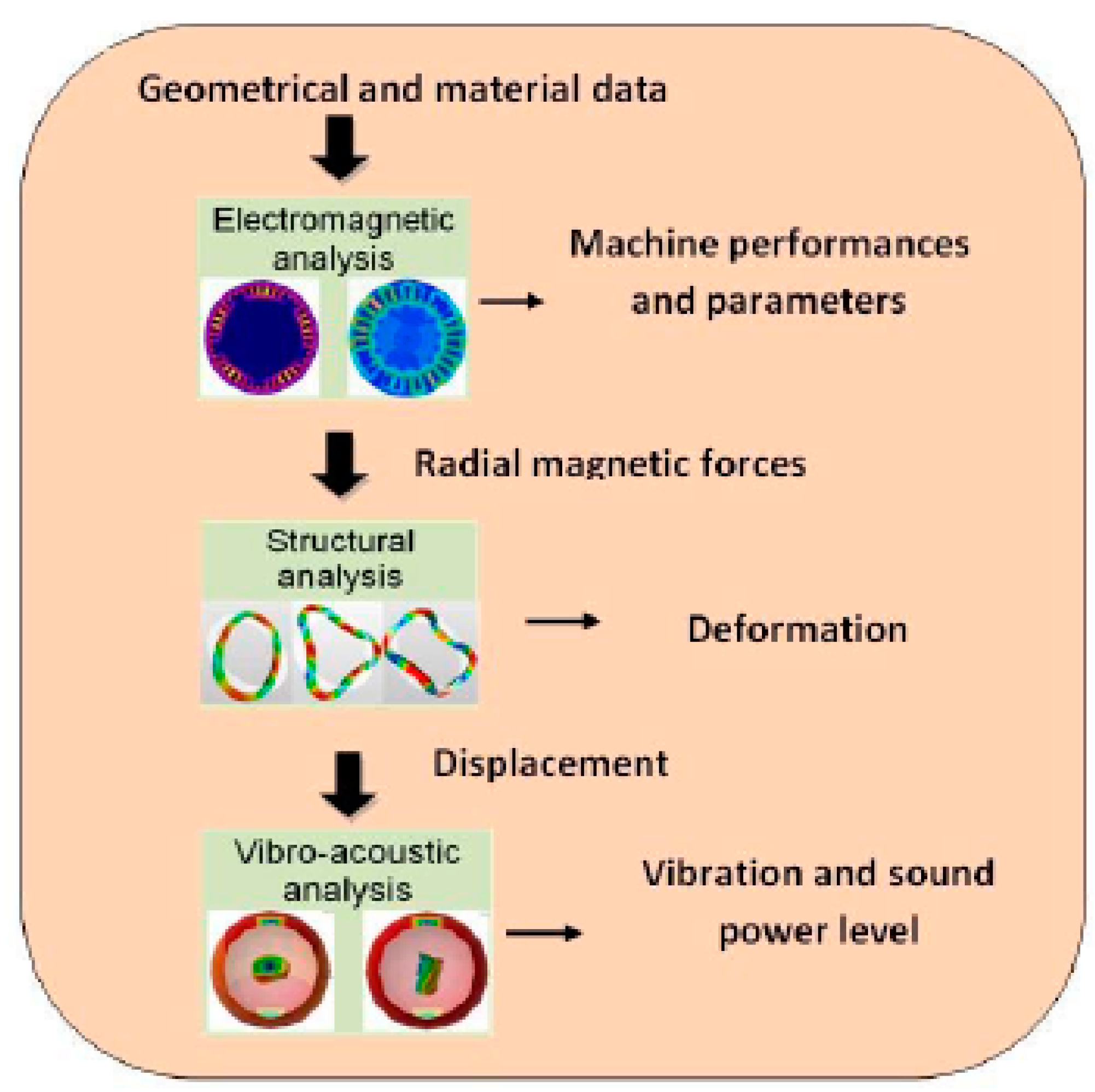
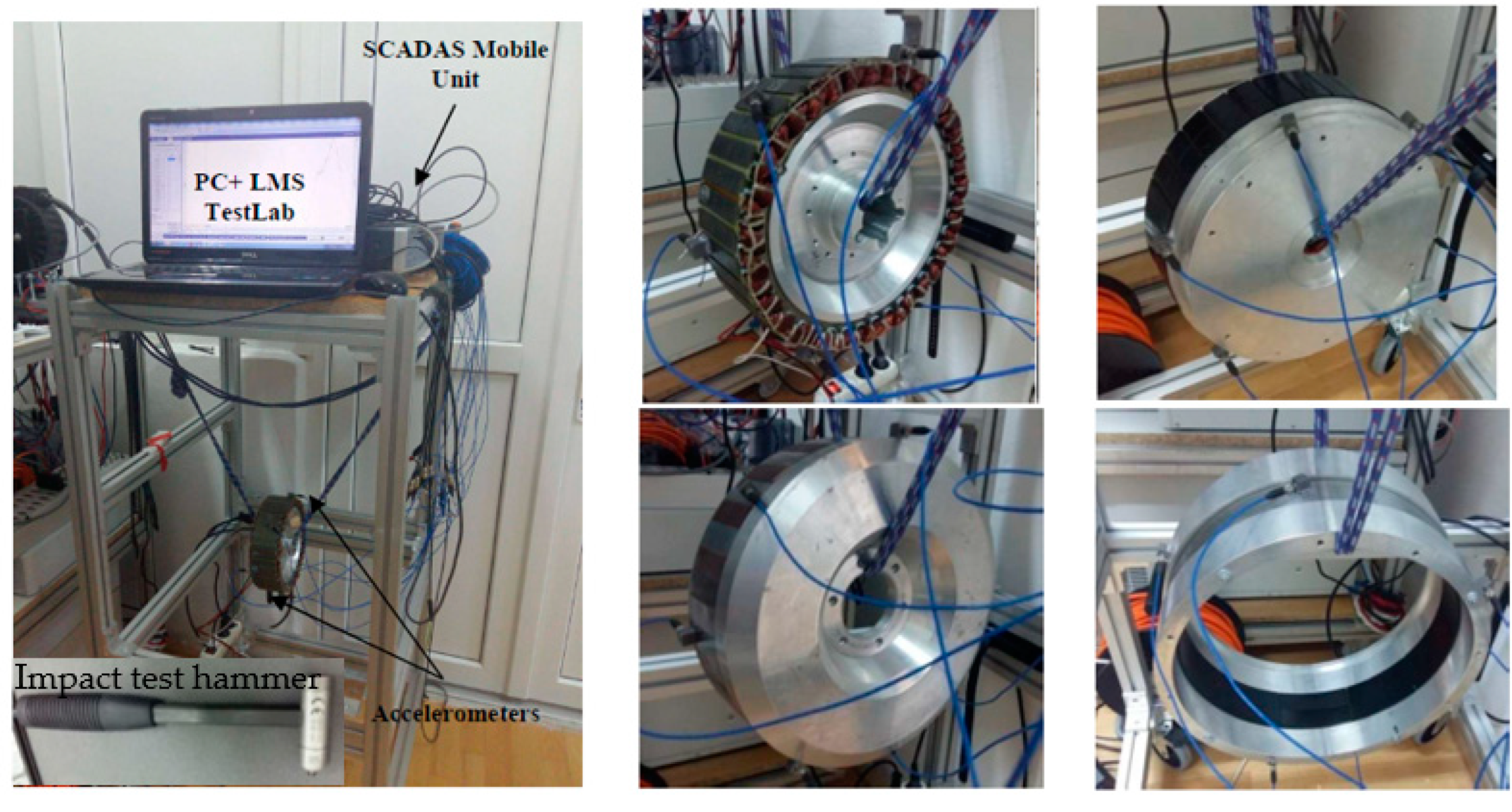
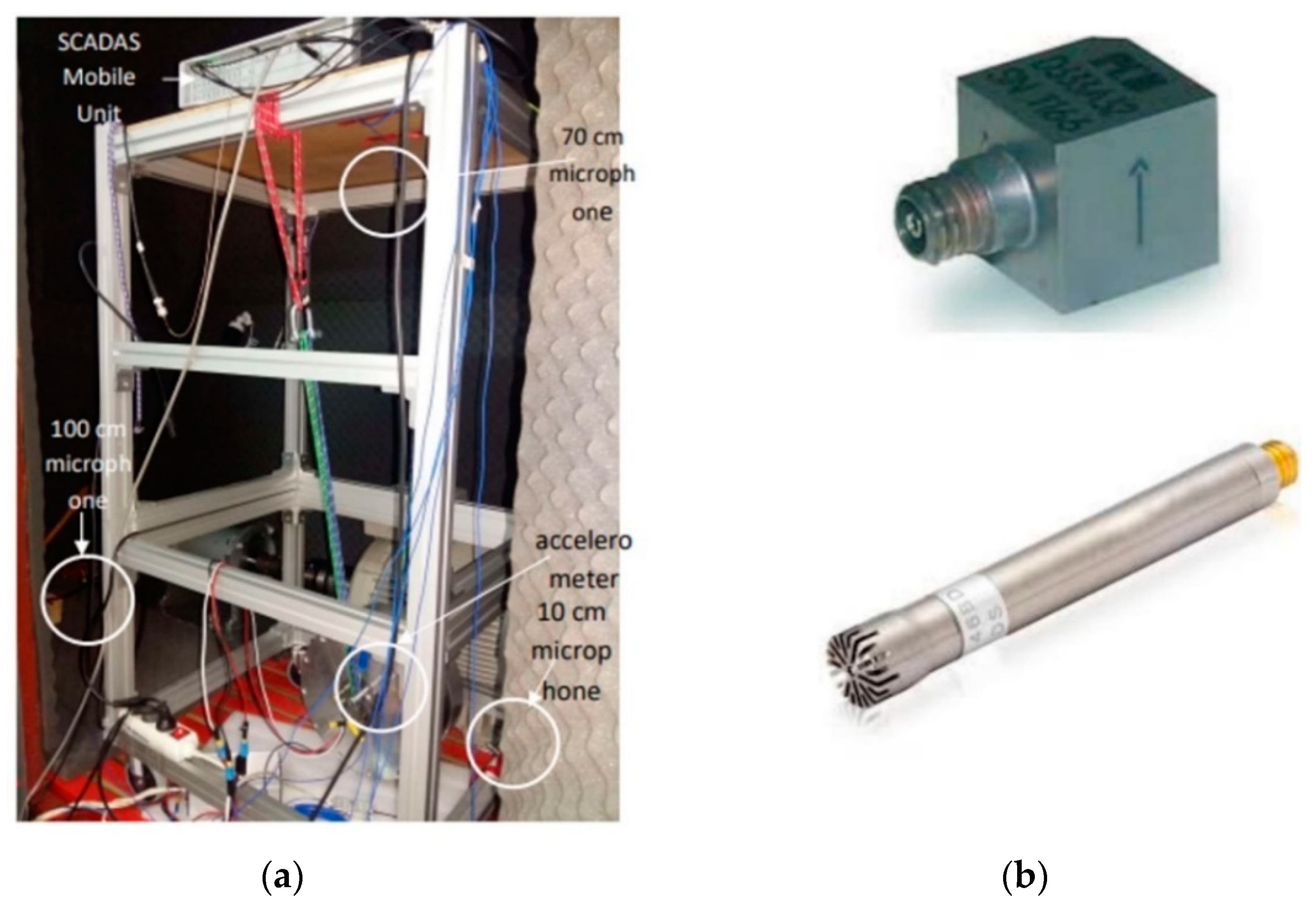
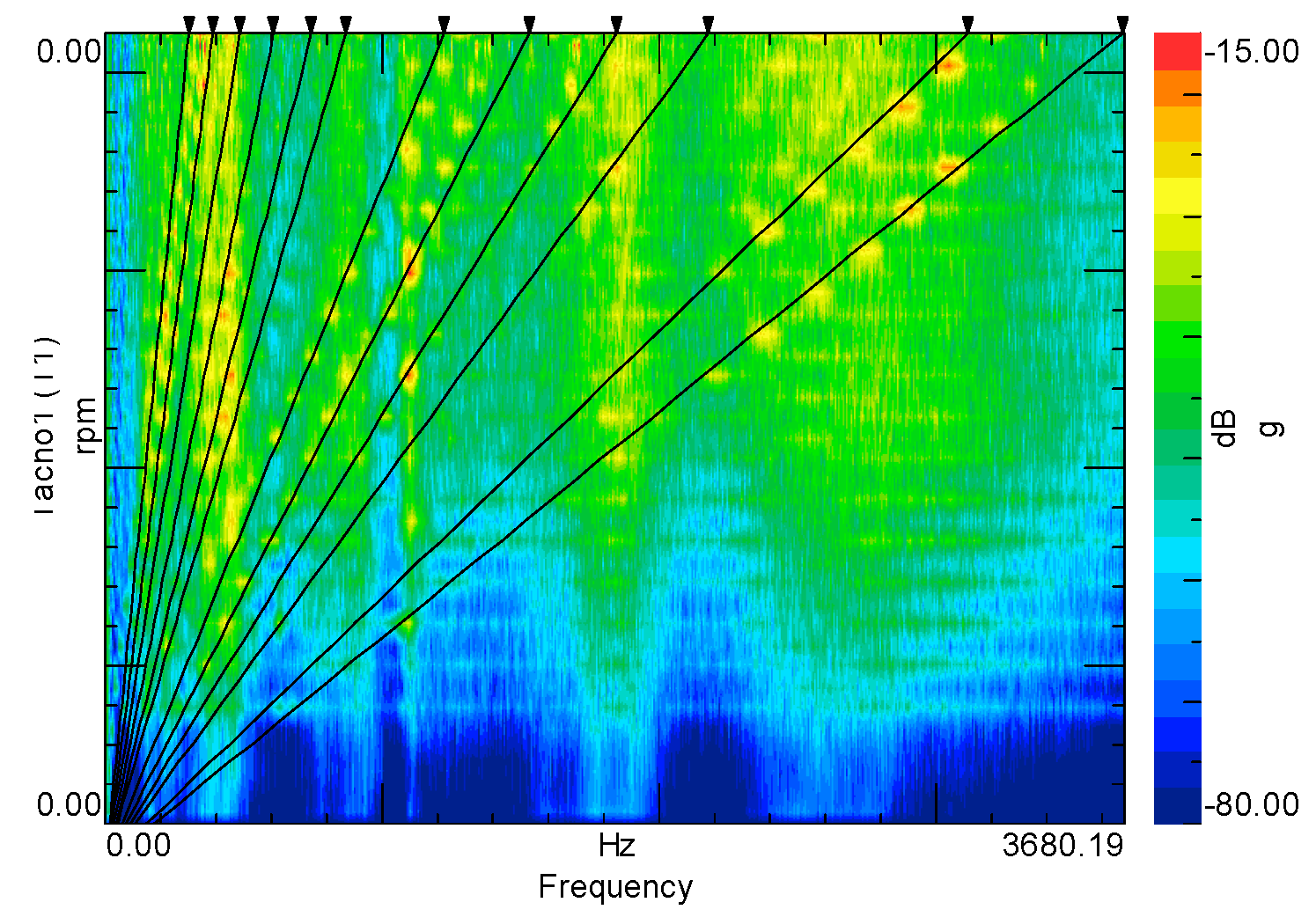

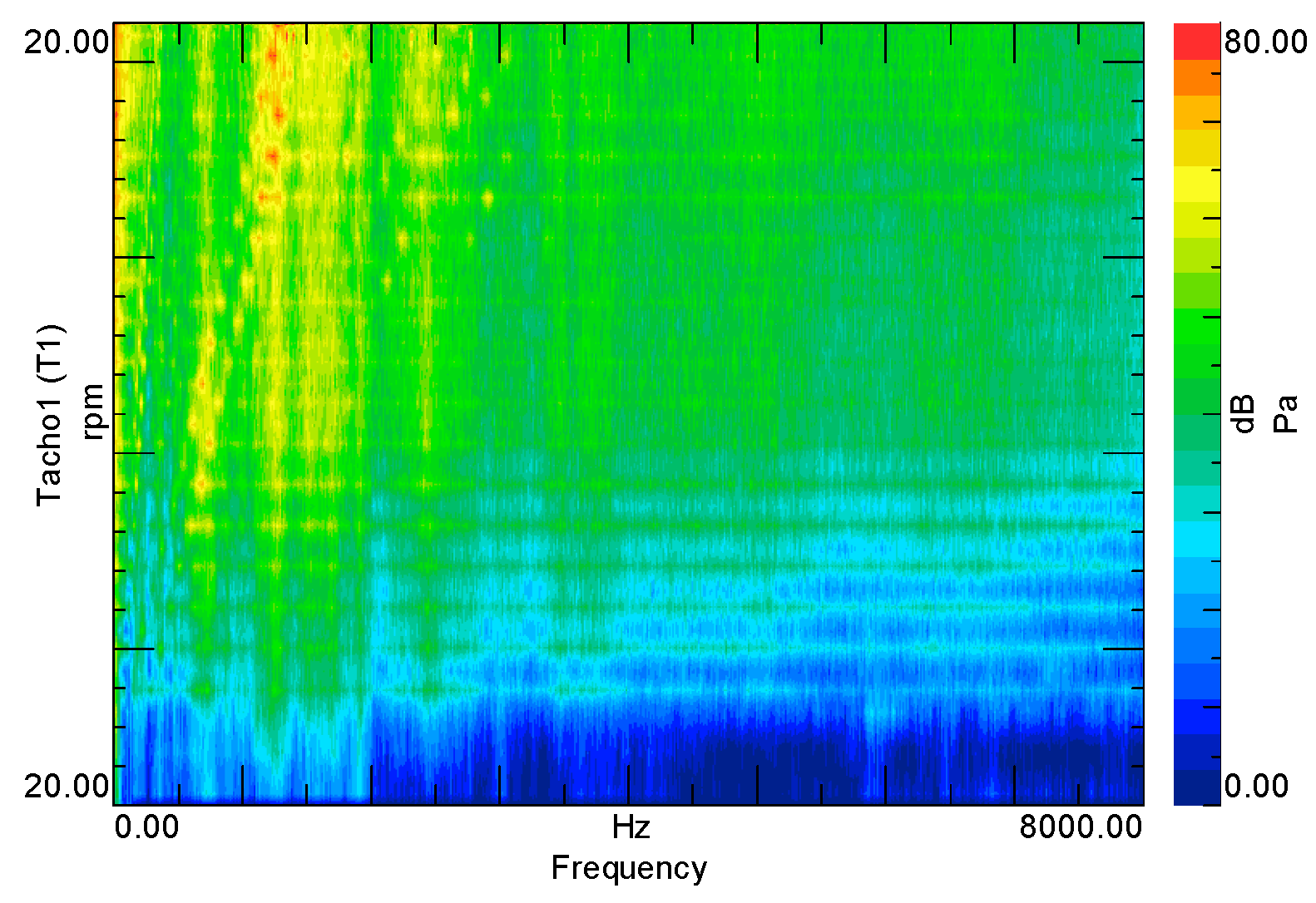
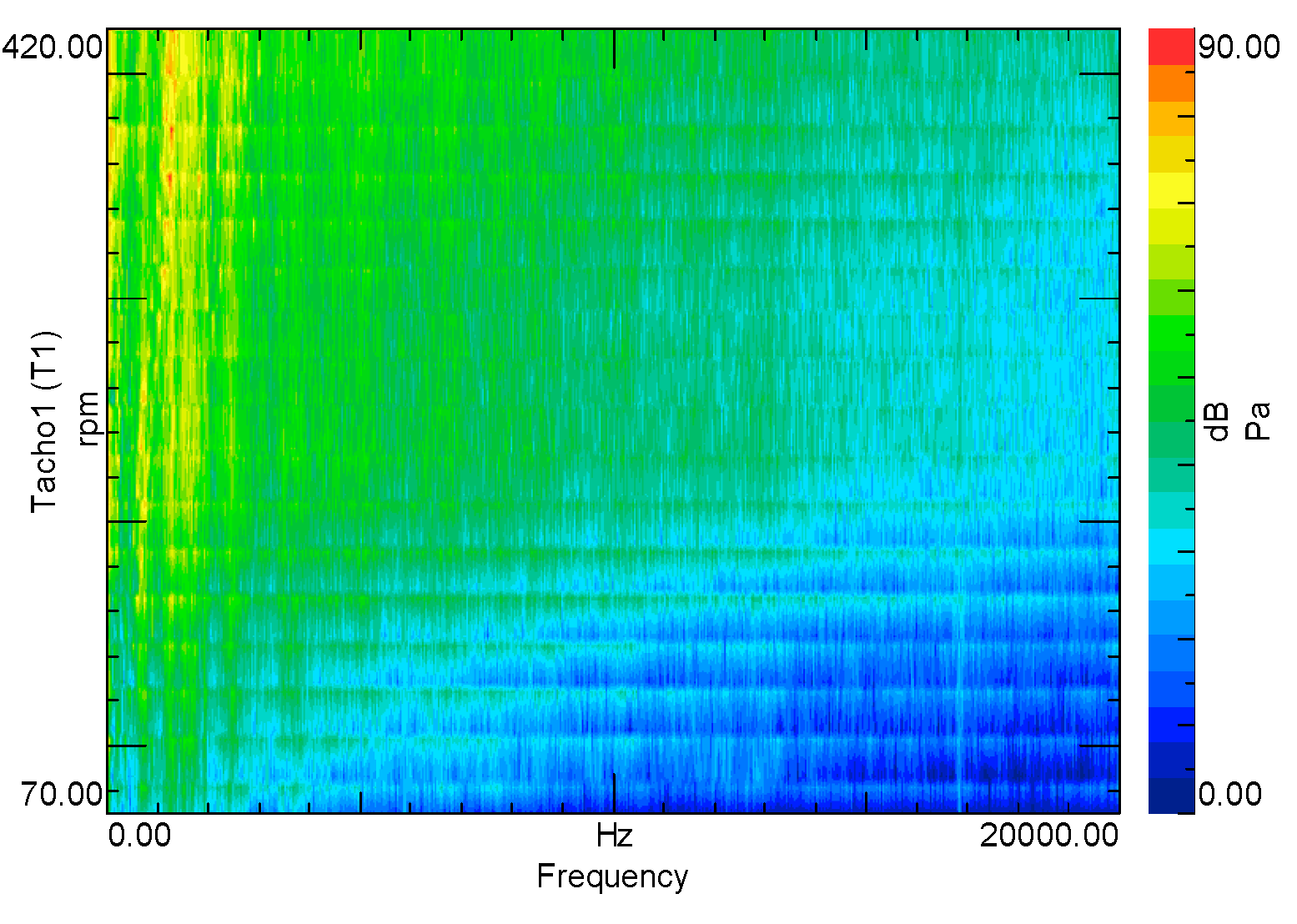


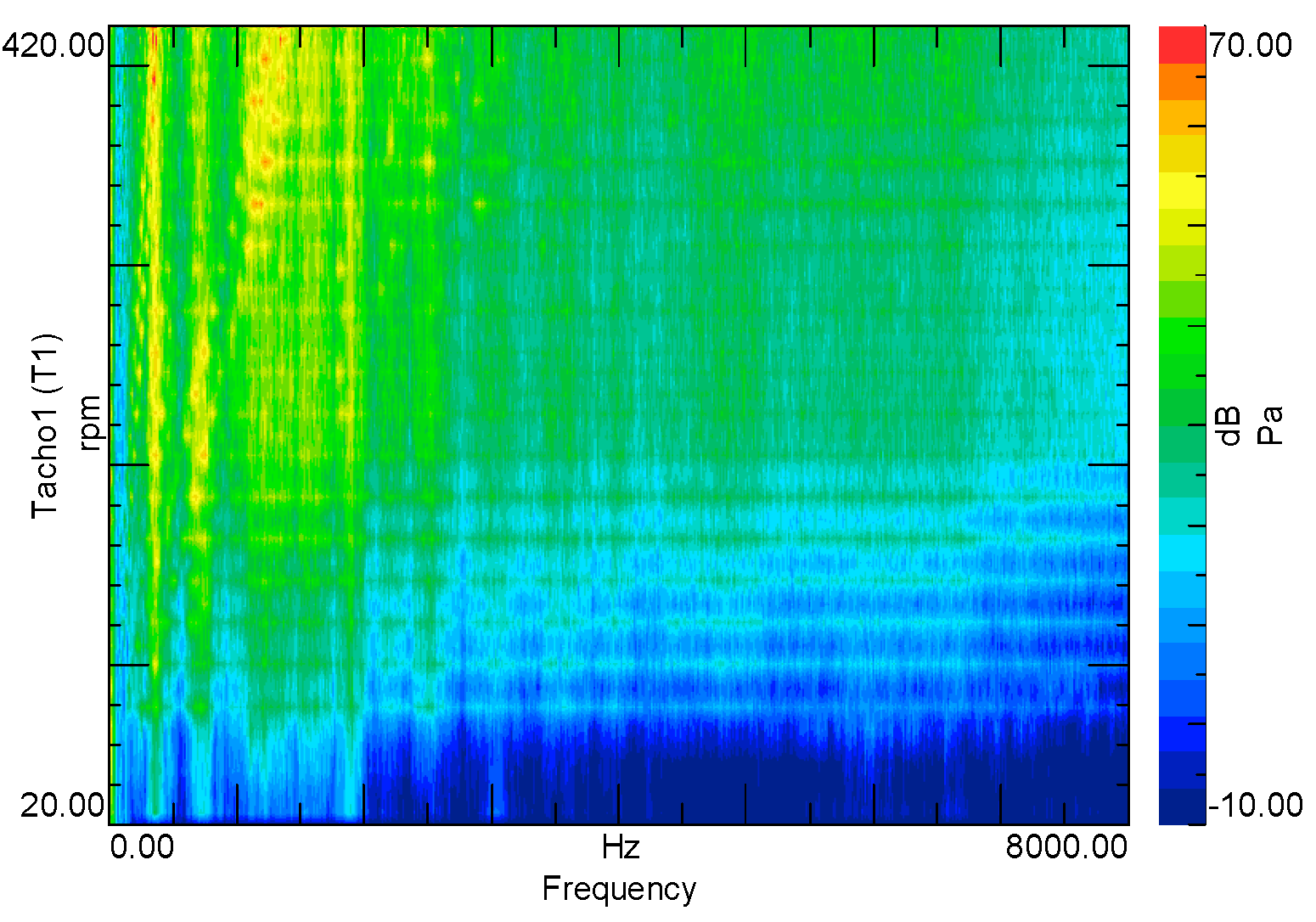
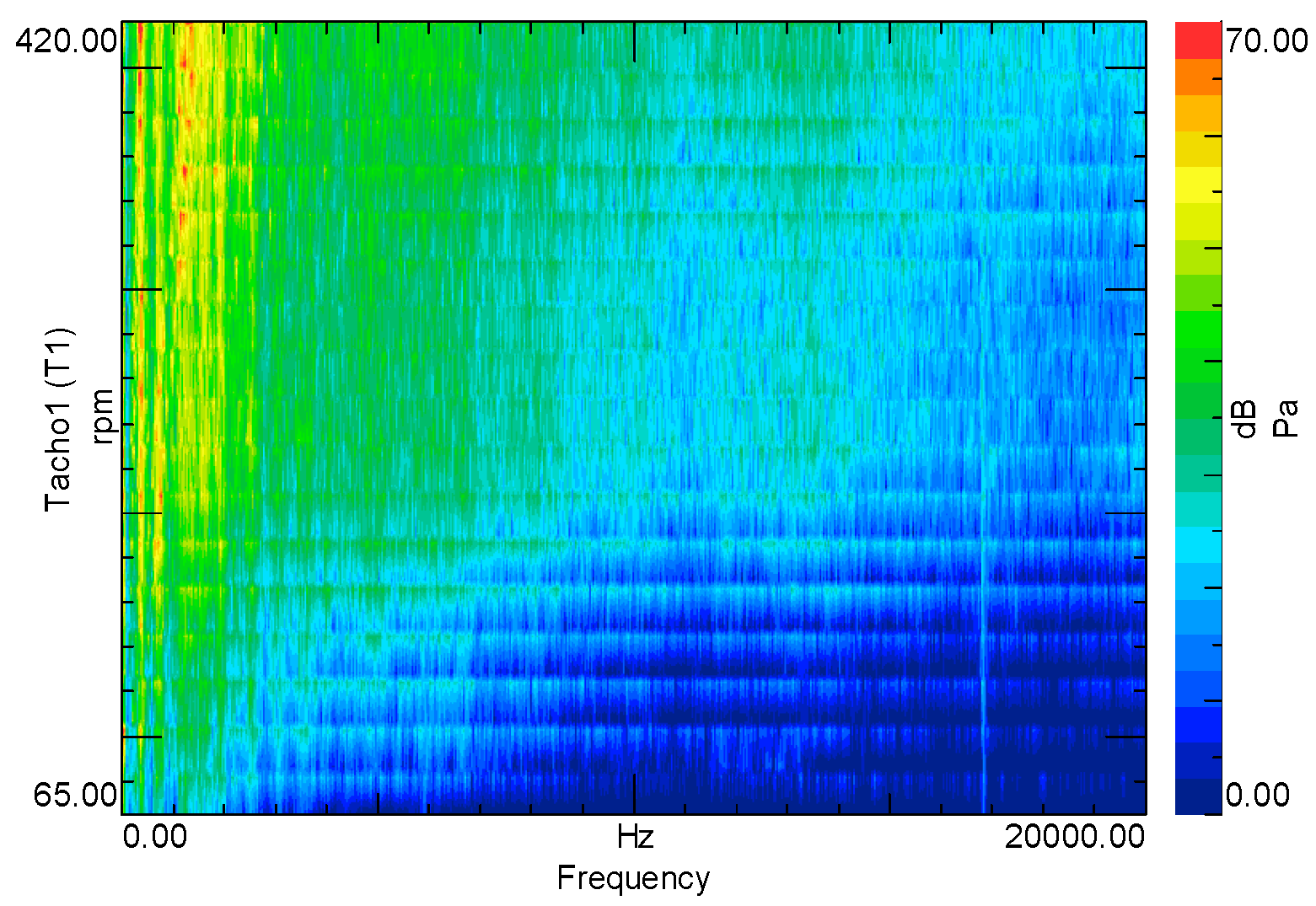
| Parameter | Value | Unit |
|---|---|---|
| Number of phases | 3 | - |
| Supplying voltage | 48 | V |
| Supplying frequency (IWM) | 119 | Hz |
| Demanded output power | 1500 | W |
| Number of pole pairs (IWM and for the inner rotor MG) | 17 | - |
| Number of the pole pairs of the outer rotor (MG) | 5 | - |
| Stator slots number (IWM) | 39 | - |
| Static part slot teeth number (MG) | 22 | |
| Rated speed (IWM and inner rotor for MG) | 420 | r/min |
| Outer rotor speed (outer rotor speed for the MG) | 1428 | r/min |
| Rated torque | 34 | N∙m |
| Material | Property (Unit) | Value | Density (kg/m3) |
|---|---|---|---|
| Copper | Electric resistivity (Ω∙m) | 2.438 × 10−8 | 8954 |
| Air | Magnetic permeability (m∙kg/A2∙s2) | 1.2566 × 10−8 | 0.9996 (at 100 °C) |
| NdFeB | Remanent flux density (T) | 1.11 | 7400 |
| Magnetic field coercivity (kA/m) | 9907 | ||
| Relative magnetic permeability | 1.05 | ||
| M530 | Flux density saturation limit (T) | 1.8 | 7800 |
| Stacking coefficient of the steel sheets | 0.95 | ||
| Conductivity of the steel sheets (A2∙s2/m3∙kg) | 4 × 106 |
| Parameter | Value | Unit |
|---|---|---|
| Outer diameter of outer rotor | 0.182 | m |
| Height of the PM | 0.003 | m |
| Height of the static teeth of the MG | 0.014 | m |
| Outer diameter of the stator | 0.199 | m |
| Inner diameter of the stator | 0.153 | m |
| Criterion | IWM + Separate Mechanical Gear | Proposed IWM-IMG |
|---|---|---|
| Mass | 48 kg | 32.3 kg |
| Strong point | Not expensive | Robustness, Efficiency |
| Weak point | Weak volume and efficiency | Expensive |
| Mode Number | 1 | 2 | 3 | 4 | 5 |
|---|---|---|---|---|---|
| Modal shape |  |  |  |  |  |
| Structure | Modal Order | Frequency (Hz) |
|---|---|---|
| Stator | 2 | 1491 |
| 3 | 2750 | |
| 4 | 4592 | |
| Inner rotor | 2 | 802 |
| 3 | 1137 | |
| 4 | 2949 | |
| SPP | 2 | 649 |
| 3 | 1551 | |
| 4 | 2819 | |
| Outer rotor | 2 | 440 |
| 3 | 1561 | |
| 4 | 2838 | |
| MG | 2 | 1694 |
| 3 | 3123 | |
| 4 | 5938 |
| Description | Material | ||
|---|---|---|---|
| Aluminum | Steel | NdFeB | |
| Density (Kg/m3) | 2710 | 7860 | 7500 |
| Young modulus (N/m2) | 7 × 1010 | 2 × 1011 | 1.6 × 1012 |
| Poisson’s ratio | 0.346 | 0.266 | 0.24 |
| Mode 2 | Mode 3 | Mode 4 | |
|---|---|---|---|
| Stator |  1419 Hz | 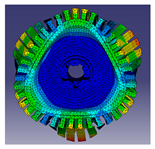 3068 Hz | 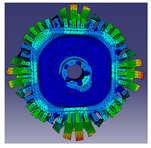 4680 Hz |
| Inner rotor | 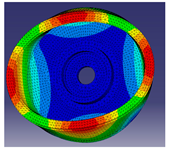 838 Hz |  1810 Hz | 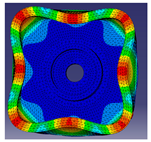 2906 Hz |
| SPP | 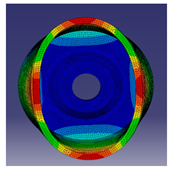 788 Hz | 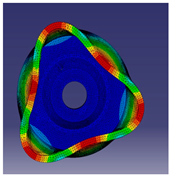 1547 Hz | 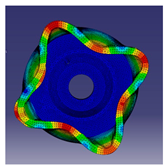 2416 Hz |
| Outer rotor |  539 Hz | 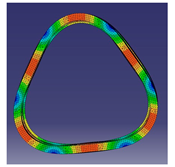 1482 Hz | 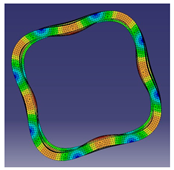 2730 Hz |
| IWM-IMG | 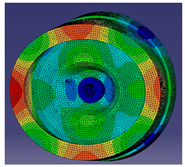 2047 Hz | 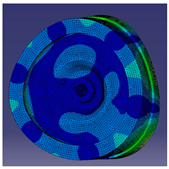 3033 Hz | 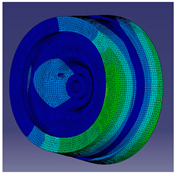 5061 Hz |
| Stator | 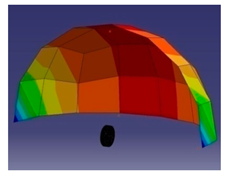 |  |
| Inner rotor |  |  |
| SPP | 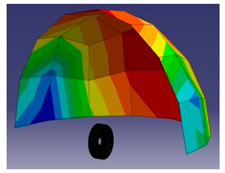 |  |
| Outer rotor | 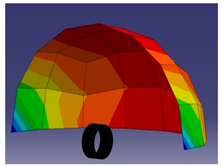 |  |
| IWM-IMG | 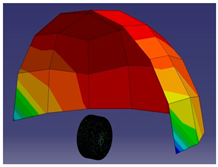 |  |
| Distance (cm) | Frequency (Hz) | Sound Power Level (dB) |
|---|---|---|
| 100 | 8 | 82.1 |
| 70 | 8 | 87.3 |
| 10 | 8 | 91.2 |
| Mode 2 | Mode 3 | Mode 4 | |
|---|---|---|---|
| Stator | 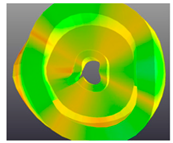 1393 Hz | 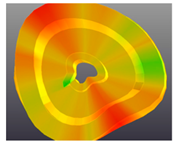 3040 Hz | 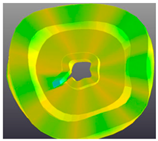 4668 Hz |
| Inner rotor |  790 Hz |  1751 Hz | 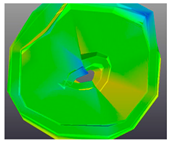 2676 Hz |
| SPP | 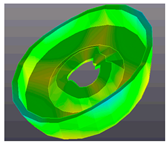 637 Hz | 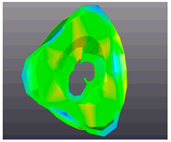 1197 Hz | 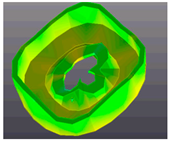 2228 Hz |
| Outer rotor | 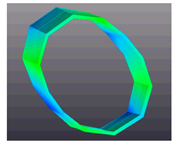 435 Hz | 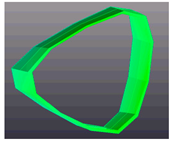 1203 Hz | 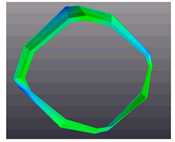 2236 Hz |
| IWM-IMG | 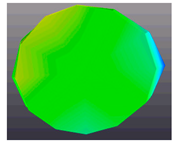 1542 Hz |  3722 Hz | 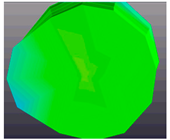 6225 Hz |
| Parameter | Analytical | FEM | Experimental Tests |
|---|---|---|---|
| Stator structural response | 2–1491 Hz | 2–1347 Hz | 2–1393 Hz |
| 3–2750 Hz | 3–2934 Hz | 3–3040 Hz | |
| 4–4592 Hz | 4–4398 Hz | 4–4668 Hz | |
| Inner rotor structural response | 2–802 Hz | 2–838 Hz | 2–790 Hz |
| 3–1137 Hz | 3–1810 Hz | 3–1751 Hz | |
| 4–2949 Hz | 4–2784 Hz | 4–2676 Hz | |
| SPP structural response | 2–649 Hz | 2–623 Hz | 2–637 Hz |
| 3–1551 Hz | 3–1329 Hz | 3–1197 Hz | |
| 4–2819 Hz | 4–2145 Hz | 4–2228 Hz | |
| MG outer rotor structural response | 2–440 Hz | 2–429 Hz | 2–435 Hz |
| 3–1561 Hz | 3–1182 Hz | 3–1203 Hz | |
| 4–2838 Hz | 4–2177 Hz | 4–2236 Hz | |
| IWM-IMG structural response | 2–1694 Hz | 2–1502 Hz | 2–1542 Hz |
| 3–3123 Hz | 3–3593 Hz | 3–3722 Hz | |
| 4–5938 Hz | 4–5865 Hz | 4–6225 Hz |
| Results | Distance of Measurement (cm) | Frequency (kHz) | Noise Level (dB) |
|---|---|---|---|
| FEM | 10 | 8 | 91.2 |
| 70 | 87.3 | ||
| 100 | 82.1 | ||
| Experimental tests | 10 | 8 | 80 |
| 70 | 75 | ||
| 100 | 70 | ||
| FEM | 10 | 20 | 101 |
| 70 | 94.5 | ||
| 100 | 87.3 | ||
| Experimental tests | 10 | 20 | 90 |
| 70 | 80 | ||
| 100 | 70 |
Publisher’s Note: MDPI stays neutral with regard to jurisdictional claims in published maps and institutional affiliations. |
© 2022 by the authors. Licensee MDPI, Basel, Switzerland. This article is an open access article distributed under the terms and conditions of the Creative Commons Attribution (CC BY) license (https://creativecommons.org/licenses/by/4.0/).
Share and Cite
Pop, C.V.; Fodorean, D.; Popa, D.-C. Structural Analysis of an In-Wheel Motor with Integrated Magnetic Gear Designed for Automotive Applications. Sustainability 2022, 14, 12007. https://doi.org/10.3390/su141912007
Pop CV, Fodorean D, Popa D-C. Structural Analysis of an In-Wheel Motor with Integrated Magnetic Gear Designed for Automotive Applications. Sustainability. 2022; 14(19):12007. https://doi.org/10.3390/su141912007
Chicago/Turabian StylePop, Claudia Violeta, Daniel Fodorean, and Dan-Cristian Popa. 2022. "Structural Analysis of an In-Wheel Motor with Integrated Magnetic Gear Designed for Automotive Applications" Sustainability 14, no. 19: 12007. https://doi.org/10.3390/su141912007
APA StylePop, C. V., Fodorean, D., & Popa, D.-C. (2022). Structural Analysis of an In-Wheel Motor with Integrated Magnetic Gear Designed for Automotive Applications. Sustainability, 14(19), 12007. https://doi.org/10.3390/su141912007







